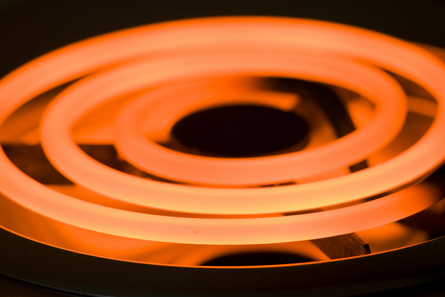Module 6
1. Module 6
1.3. Lesson 1
Module 6—Wave-Particle Duality and Quantum Physics
Lesson 1—Blackbody Radiation and the Quantum
 Get Focused
Get Focused

© Alexey Stiop/shutterstock
How can you tell when a stove element is hot? When it is off, it appears black and is cool to the touch. Turn the electric current on and it starts to warm up, slowly taking on a red glow that becomes more and more intense. We have come to associate the colour red with things that are hot, like the coals in a fire or the small wires in your toaster. At even greater temperatures, objects appear white, indicating the presence of many wavelengths of light being emitted. The filament in an incandescent light bulb is a good example of something that is nearly white-hot.
These simple observations indicate that there is a relationship between the temperature of a body and the wavelength of the electromagnetic energy it emits. This relationship is described by blackbody radiation curves. Initially, the relationship between temperature and the wavelength of the emitted radiation didn’t seem very complex, but classical physics was not able to explain it. Hence, quantum physics was born to explain the relationship between temperature and the wavelength of emitted radiation.
In this lesson you will learn about blackbody radiation and the idea of the quantum.
In this lesson you will answer the following essential questions:
- How is blackbody radiation illustrated graphically?
- What is the relationship between colour and temperature?
- What are a quantum and a photon?
 Module 6: Lesson 1 Assignment
Module 6: Lesson 1 Assignment
Your teacher-marked Module 6: Lesson 1 Assignment requires you to submit responses to the following:
- Assignment—A 1, A 2, A 3, A 4, A 5, A 6, and A 7
- Discuss—D 3
The other questions in this lesson are not marked by the teacher; however, you should still answer these questions. The Self-Check and Try This questions are placed in this lesson to help you review important information and build key concepts that may be applied in future lessons.
After a discussion with your teacher, you must decide what to do with the questions that are not part of your assignment. For example, you may decide to submit to your teacher the responses to Try This questions that are not marked. You should record the answers to all the questions in this lesson and place those answers in your course folder.